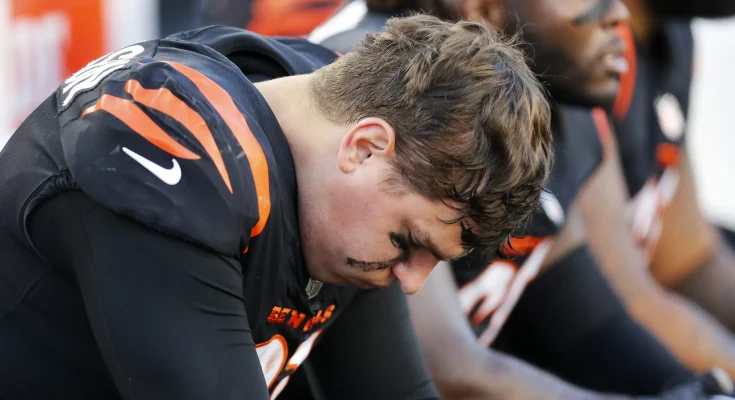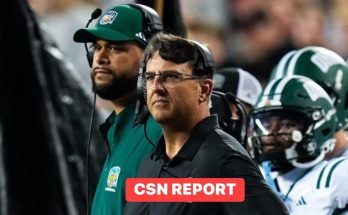Despite putting an end to the Shemar Stewart contract debacle, the Cincinnati Bengals remain embroiled in a standoff with star defensive end Trey Hendrickson. The cloud of uncertainty hanging over Paycor Stadium has not dissipated despite the front office successfully navigating through one of the offseason’s more bizarre sagas with Stewart, who was a no-show for the start of training camp due to contract concerns and uncommunicated personal matters. The team managed to calm the waters with the former Texas A\&M edge prospect, but the larger, more pressing storm remains: a stalemate with their premier pass rusher, who has become not only a foundational figure in the Bengals’ defense but also a face of their identity on the field.
Hendrickson, entering the final year of a four-year, \$60 million deal signed in 2021, has made his frustrations with the front office known. Despite being one of the most productive edge rushers in the NFL since arriving in Cincinnati, he has not received the long-term financial commitment he believes he’s earned. His absence from voluntary OTAs was the first warning shot, but when he skipped the team’s mandatory minicamp without an excuse, things escalated quickly. Although he avoided publicly blasting the franchise, those close to the situation have described his demeanor as increasingly disillusioned with how the Bengals are handling negotiations, especially considering the market-shifting contracts being handed out to edge rushers around the league.
For Cincinnati, this presents a complex challenge. The Bengals have always taken a relatively cautious approach to second contracts, especially when it comes to players nearing or past their physical prime. Hendrickson turns 30 in December, and while his numbers—17.5 sacks in 2023, 14 quarterback hits, and five forced fumbles—paint the picture of an elite disruptor, there’s a philosophical hesitation within the front office to extend large deals to defensive players past their late twenties. The concern isn’t so much about Hendrickson’s current performance but rather the long-term risk associated with committing top-tier edge rusher money well into his thirties.
That perspective, however, doesn’t seem to be flying with Hendrickson’s camp. His representatives point to his production as not only consistent but trending upward, and they argue that in an era where conditioning, recovery, and injury prevention have extended the shelf lives of elite pass rushers, age-based conservatism is outdated. Hendrickson himself has remained in elite shape and has reportedly adopted cutting-edge training and nutrition regimens that rival those of younger players. There’s also the intangible factor: leadership. Teammates and coaches alike speak glowingly about his preparation, his locker room presence, and his fiery demeanor on game day. Losing that kind of influence wouldn’t just hurt the Bengals on the edge—it would reverberate throughout the defense.
The Bengals, meanwhile, are trying to project strength publicly. Head coach Zac Taylor has offered short, non-committal statements regarding the situation, typically saying that Hendrickson is “a valued member of the team” and that “these things work themselves out.” But behind the scenes, there is increasing concern about the optics of another contract impasse following the Stewart fiasco. While Stewart’s issue was primarily related to rookie guarantees and miscommunications involving his representation, the organization was still criticized for the perceived lack of clarity and proactive leadership. Now, facing similar heat with a marquee veteran, Cincinnati’s leadership structure is under the microscope again.
Adding further tension is the locker room dynamic. Multiple Bengals veterans have come out in support of Hendrickson, both publicly and privately. Joe Burrow, a voice that carries considerable weight within the organization, has reportedly had conversations with front office members urging them to resolve the situation sooner rather than later. Burrow, known for his cool demeanor and team-first mentality, recognizes the importance of Hendrickson not just as a playmaker but as an emotional catalyst for the defense. “We want him here,” Burrow told reporters last week. “He’s part of what makes us go. We all know how valuable he is.”
It’s hard to argue otherwise. Since joining the Bengals from New Orleans, Hendrickson has elevated the defensive unit’s ceiling. His motor, technique, and explosiveness off the edge have made him one of the most feared rushers in the AFC. He’s been instrumental in Cincinnati’s playoff runs, frequently disrupting opposing quarterbacks in critical moments. He is not the kind of player who fades in big games—he rises. And that’s the kind of edge presence that few teams can afford to lose if they’re serious about contending for a Super Bowl.
But money talks in the NFL, and it appears the Bengals are testing the limits of Hendrickson’s patience. There have been preliminary offers floated, but sources indicate those offers fall well short of what his camp believes is a fair reflection of his market value. This comes as other edge rushers, such as Brian Burns, Josh Allen (the Jaguars linebacker, not the Bills quarterback), and Nick Bosa, have reset the market with massive guarantees and annual average salaries pushing north of \$30 million. Hendrickson isn’t asking to match Bosa’s number, but he’s not looking for a hometown discount either—especially after outperforming his current deal.
Complicating matters is the team’s cap situation. With Joe Burrow’s massive contract, along with key deals for Ja’Marr Chase and Tee Higgins looming, Cincinnati must thread a tight financial needle. Prioritizing extensions has become a balancing act between ensuring offensive continuity around Burrow and preserving the defensive identity that has quietly become a backbone of their recent success. Defensive coordinator Lou Anarumo has built his unit around pressure up front, and Hendrickson is the apex of that strategy. If he’s not on the field—or worse, if he’s shipped off or walks next offseason—it would send ripples through the entire defensive scheme.
So far, there’s no indication that a trade is imminent. The Bengals are not actively shopping Hendrickson, and sources close to the team have downplayed the idea of moving him, at least before the season begins. But the longer the standoff continues, the more likely it becomes that external interest will grow, especially from contenders looking for a final defensive piece. There’s also the question of what Hendrickson is willing to do. Would he stage a holdout into the regular season? Would he take a page from other veterans and stage a “hold-in”—showing up but refusing to participate until a deal is reached? Or would he, reluctantly, play out the year and test free agency in 2026?
That last option may be the riskiest for Cincinnati. If Hendrickson puts up another Pro Bowl season—and there’s little reason to think he won’t—his value will only increase. At that point, Cincinnati will face even more competition in retaining him, and the leverage Hendrickson holds now will only multiply. Moreover, the team’s defensive continuity could be at risk if teammates view the situation as a sign of poor loyalty from the front office. NFL locker rooms are tight-knit, and while everyone understands the business side, players notice how their teammates are treated. A prolonged battle with Hendrickson could have ramifications that reach beyond just one player.
The Bengals, by most accounts, are on the precipice of something special. With Joe Burrow healthy, a deep offensive skill group, and a young, fast defense, they’re in the conversation for a title run again in 2025. But distractions like this are the kinds of things that can quietly erode momentum. The NFL calendar moves fast, and what seems like a minor impasse in July can snowball into a full-blown crisis by September. Hendrickson isn’t the kind of player a team can afford to mishandle—he’s too productive, too respected, and too important.
For now, the standoff continues. Hendrickson remains absent, the team remains silent, and fans remain anxious. It’s a waiting game, and every day that passes without resolution brings more pressure on the Bengals to decide whether they’re going to double down on the veteran who helped redefine their defense—or risk watching that identity slowly unravel.



